The past decade has witnessed some dramatic methodological changes in the wider disciplines of psycholinguistics, psychology, and experimental linguistics. One such set of changes comprises the development of open and transparent research practices, which have increasingly been adopted in response to concerns that empirical results often fail to replicate and may not generalise across samples and experimental conditions (Gibson & Fedorenko, 2013; Maxwell, Lau, & Howard, 2015; McElreath & Smaldino, 2015; Yarkoni, 2020). Another important set of changes concerns the use of sophisticated statistical techniques, such as mixed-effects models (Baayen, Davidson, & Bates, 2008) and Bayesian analyses (Vasishth, Nicenboim, Beckman, Li & Kong, 2018), which can provide much more information about magnitudes of effects and sources of variation than the more traditional statistical approaches.
